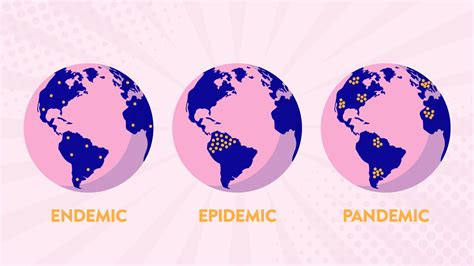Pandemic What Is

The word "pandemic" has become a part of our collective vocabulary, especially in recent years. It's a term that evokes a sense of global unity and shared experience, as we navigate through challenging times together. But what exactly is a pandemic, and how does it differ from other types of outbreaks or epidemics? This article aims to delve into the depths of pandemics, exploring their definitions, causes, and impacts, as well as the crucial role of public health measures in managing them.
Understanding Pandemics: Definitions and Characteristics

A pandemic is a global outbreak of a disease, characterized by its spread across multiple countries or continents, affecting a large number of people.
The World Health Organization (WHO) defines a pandemic as “the worldwide spread of a new disease.”
Unlike epidemics, which are localized outbreaks within a specific population or region, pandemics have a much broader reach and can impact populations worldwide.
Key characteristics of pandemics include:
- Novel Pathogen: Pandemics often involve the emergence of a new virus or a mutated strain, against which humans have little to no immunity.
- Rapid Global Spread: The disease spreads quickly, often facilitated by modern travel and transportation, leading to a global impact within a short period.
- Severe Health Impact: Pandemics can cause a significant increase in morbidity and mortality rates, affecting all age groups and demographics.
- Social and Economic Disruption: Beyond health consequences, pandemics can disrupt social, economic, and political systems, impacting daily life and global stability.
Historical Pandemics: A Retrospective

The history of pandemics is a testament to the resilience of humanity and the importance of public health measures.
Some notable pandemics include:
- The Black Death (1346-1353): Caused by the bacterium Yersinia pestis, this pandemic devastated populations across Europe, Asia, and Africa, killing an estimated 75-200 million people.
- The Spanish Flu (1918-1920): One of the deadliest pandemics in history, the Spanish Flu infected an estimated 500 million people worldwide, resulting in at least 50 million deaths. It highlighted the importance of global collaboration in managing pandemics.
- HIV/AIDS Pandemic (1981-present): The HIV/AIDS pandemic, still ongoing, has resulted in over 36 million deaths since its discovery. It has been a driving force for advancements in healthcare and public health infrastructure.
Lessons from History
Historical pandemics have taught us the importance of:
- Swift Action: Early and decisive interventions can significantly reduce the impact of a pandemic.
- International Cooperation: Global collaboration is crucial for sharing resources, knowledge, and strategies to combat pandemics effectively.
- Public Health Infrastructure: Well-equipped and well-funded public health systems are essential for managing pandemics and protecting vulnerable populations.
Causes and Risk Factors: Unraveling the Pandemic Puzzle
Pandemics can be caused by various pathogens, including viruses, bacteria, and parasites. However, certain factors increase the risk of a pandemic:
- Emerging Pathogens: New viruses or mutated strains can evade existing immunity and cause widespread infection.
- Rapid Global Travel: Modern transportation allows pathogens to spread quickly across borders, reaching new populations before effective containment measures can be implemented.
- Animal-Human Transmission: Many pandemics originate from animal reservoirs, with zoonotic diseases jumping from animals to humans.
- Weakened Immune Systems: Factors like malnutrition, chronic diseases, and lack of access to healthcare can make populations more susceptible to severe infections.
The Role of Surveillance and Preparedness
Surveillance systems play a critical role in identifying potential pandemic threats early on. By monitoring disease trends and conducting regular testing, public health authorities can:
- Detect emerging pathogens.
- Track the spread of diseases.
- Implement targeted interventions.
Additionally, pandemic preparedness plans outline strategies for managing outbreaks, including:
- Resource allocation.
- Vaccine development and distribution.
- Public health communication.
- Social and economic support measures.
Impact and Management: Navigating the Pandemic Journey
The impact of a pandemic extends far beyond the immediate health consequences. It can disrupt social and economic structures, strain healthcare systems, and cause widespread fear and anxiety.
Effective management of pandemics requires a multi-faceted approach, including:
- Public Health Measures: Implementing measures like social distancing, quarantine, and isolation can help slow the spread of the disease.
- Healthcare Capacity: Ensuring healthcare systems have the resources and capacity to manage the influx of patients is crucial.
- Community Engagement: Involving communities in pandemic response efforts can increase trust, promote adherence to guidelines, and provide essential support.
- Research and Innovation: Rapid development and deployment of vaccines, therapeutics, and diagnostic tools are essential for managing pandemics effectively.
The Power of Public Health Measures
Public health measures, when implemented effectively, can significantly reduce the spread of a pandemic and buy valuable time for other interventions.
| Measure | Description |
|---|---|
| Social Distancing | Maintaining physical distance from others to reduce transmission. |
| Quarantine | Separating and restricting movement of individuals who may have been exposed to the disease to see if they become sick. |
| Isolation | Separating sick individuals from healthy ones to prevent the spread of the disease. |
| Contact Tracing | Identifying and monitoring individuals who have come into close contact with infected persons to contain the spread. |

Future Outlook: Preparing for the Next Pandemic

While the world has made significant strides in managing pandemics, the threat of future outbreaks remains. The ongoing COVID-19 pandemic has highlighted the need for continuous improvement in pandemic preparedness and response.
Key areas for future pandemic preparedness include:
- Enhanced Surveillance: Strengthening global surveillance systems to detect and respond to emerging pathogens swiftly.
- Research Collaboration: Fostering international collaboration in research and development, particularly in vaccine and therapeutic development.
- Equitable Access: Ensuring equitable access to healthcare and public health interventions, especially in vulnerable and underserved communities.
- Resilient Healthcare Systems: Investing in resilient healthcare infrastructure to withstand the pressures of pandemics and provide quality care.
How do pandemics differ from epidemics and outbreaks?
+Pandemics are characterized by their global spread, affecting multiple countries or continents, while epidemics are localized to specific regions. Outbreaks refer to a sudden increase in cases of a disease within a specific population or region.
What are some common public health measures used during pandemics?
+Common public health measures include social distancing, quarantine, isolation, contact tracing, and the use of personal protective equipment (PPE) to reduce transmission.
How can individuals prepare for future pandemics?
+Individuals can prepare by staying informed about public health guidelines, maintaining good hygiene practices, and being proactive about their health. Additionally, having emergency supplies and a plan for self-isolation can be beneficial.



